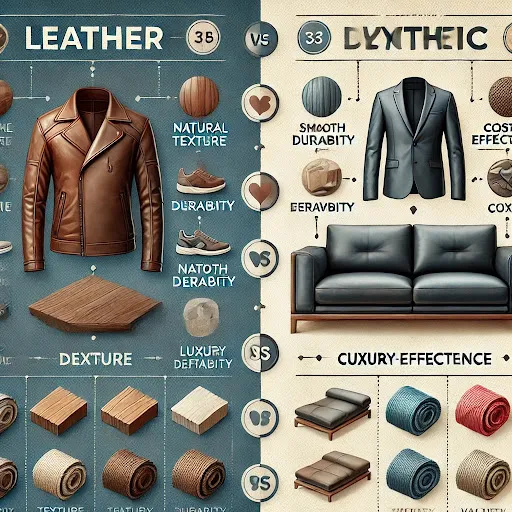When it comes to choosing materials for furniture, clothing, and accessories, the variety of leathers and leather alternatives can be confusing. Leather, faux leather, leatherette, PU (polyurethane), Rexin, PVC (polyvinyl chloride), synthetic leather, and vegan leather are all popular choices, each with its own set of characteristics, benefits, and drawbacks. This blog aims to differentiate these materials in all aspects, helping you make an informed decision based on durability, appearance, maintenance, environmental impact, and cost.
1. Genuine Leather
Description: Genuine leather is made from the hides of animals, primarily cows, although goat, buffalo, and exotic leathers are also available. It is tanned and treated to produce a durable, flexible material that ages well.
Pros:
- Durability: Highly durable and can last for decades with proper care.
- Aesthetics: Develops a patina over time, enhancing its appearance.
- Comfort: Breathable and adjusts to body temperature.
Cons:
- Cost: Generally more expensive than synthetic alternatives.
- Maintenance: Requires regular conditioning and waterproofing.
- Ethical concerns: Animal welfare and environmental impact of tanning processes.
2. Faux Leather
Description: Faux leather, also known as synthetic leather, is a fabric intended to mimic the look of real leather. It is usually made from a plastic base and then treated with wax, dye, or polyurethane for color and texture.
Pros:
- Affordable: Less expensive than real leather.
- Variety: Available in various colors and textures.
- Easy to care: Generally just needs wiping and is not prone to crack or fade as quickly as real leather.
Cons:
- Durability: Less durable than real leather; can peel or crack over time.
- Not breathable: Can feel less comfortable in hot weather.
- Environmental impact: Made from non-renewable fossil fuels, though recyclable options are increasing.
3. Leatherette
Description: Leatherette is a type of faux leather, made from fabric base covered with a plastic coating. It is designed to replicate leather more closely than other synthetics.
Pros:
- Economic: Cheaper than genuine leather.
- Low maintenance: Easy to clean and resistant to stains and water.
- Uniform appearance: Provides a consistent color and texture that does not change over time.
Cons:
- Wear and tear: Not as durable; susceptible to tears and cracks.
- Comfort: Less breathable, which might be uncomfortable in warm climates.
- Eco-friendliness: Typically not biodegradable and has a larger environmental footprint.
4. PU (Polyurethane)
Description: PU leather is a specific type of faux leather made from a synthetic backing coated with a soft polyurethane layer. It is one of the most common types of synthetic leather.
Pros:
- Flexibility: Softer than PVC, making it easier to work with in fashion.
- Vegan: Does not use animal products.
- Water-resistant: Does not absorb water, making it easy to maintain.
Cons:
- Breathability: Like other synthetics, it does not breathe.
- Durability: Can crack and wear over time.
- Environmental concerns: Though less than PVC, PU still raises concerns due to its chemical makeup.
5. Rexin
Description: Rexin is a cloth-backed vinyl that is used to mimic the look of leather more closely than other synthetic leathers. It is often used in upholstery and bookbinding.
Pros:
- Durability: Tough and durable with proper maintenance.
- Cost-effective: Cheaper than real leather.
- Easy care: Simple to clean and maintains its look over time.
Cons:
- Feel: Less soft and pliable compared to genuine leather.
- Breathability: Can feel sticky and uncomfortable in hot environments.
- Chemical smell: May emit a mild odor when new.
6. PVC (Polyvinyl Chloride)
Description: PVC leather, also known as vinyl leather, is made by applying one or more layers of PVC on top of a fabric backing.
Pros:
- Waterproof: Highly resistant to water and stains.
- Inexpensive: Generally cheaper than PU and much cheaper than real leather.
- Durable: Resistant to wear and tear in mild conditions.
Cons:
- Stiffness: Tends to be stiffer than other faux leathers.
- Environmental impact: Releases dioxins during manufacture and disposal, which are harmful to the environment.
- Comfort: The least breathable of faux leathers, making it uncomfortable for clothing.
7. Vegan Leather
Description: Vegan leather is a term used for all synthetic leathers that do not use animal products. It can be made from PU, PVC, or innovative materials like pineapple leaves, cork, and apple peels.
Pros:
- Ethical: No animals are harmed in the production.
- Innovative materials: Often incorporates recycled and sustainable materials.
- Variety: Available in many textures and colors.
Cons:
- Durability and feel: Varies widely depending on the materials used.
- Cost: Some high-end vegan leathers can be expensive.
- Care and longevity: May require specific care instructions depending on the base material.
In conclusion, the choice between these materials depends largely on personal priorities such as budget, ethics, environmental concerns, and intended use. Understanding these aspects helps in making a decision that aligns with your values and needs.

